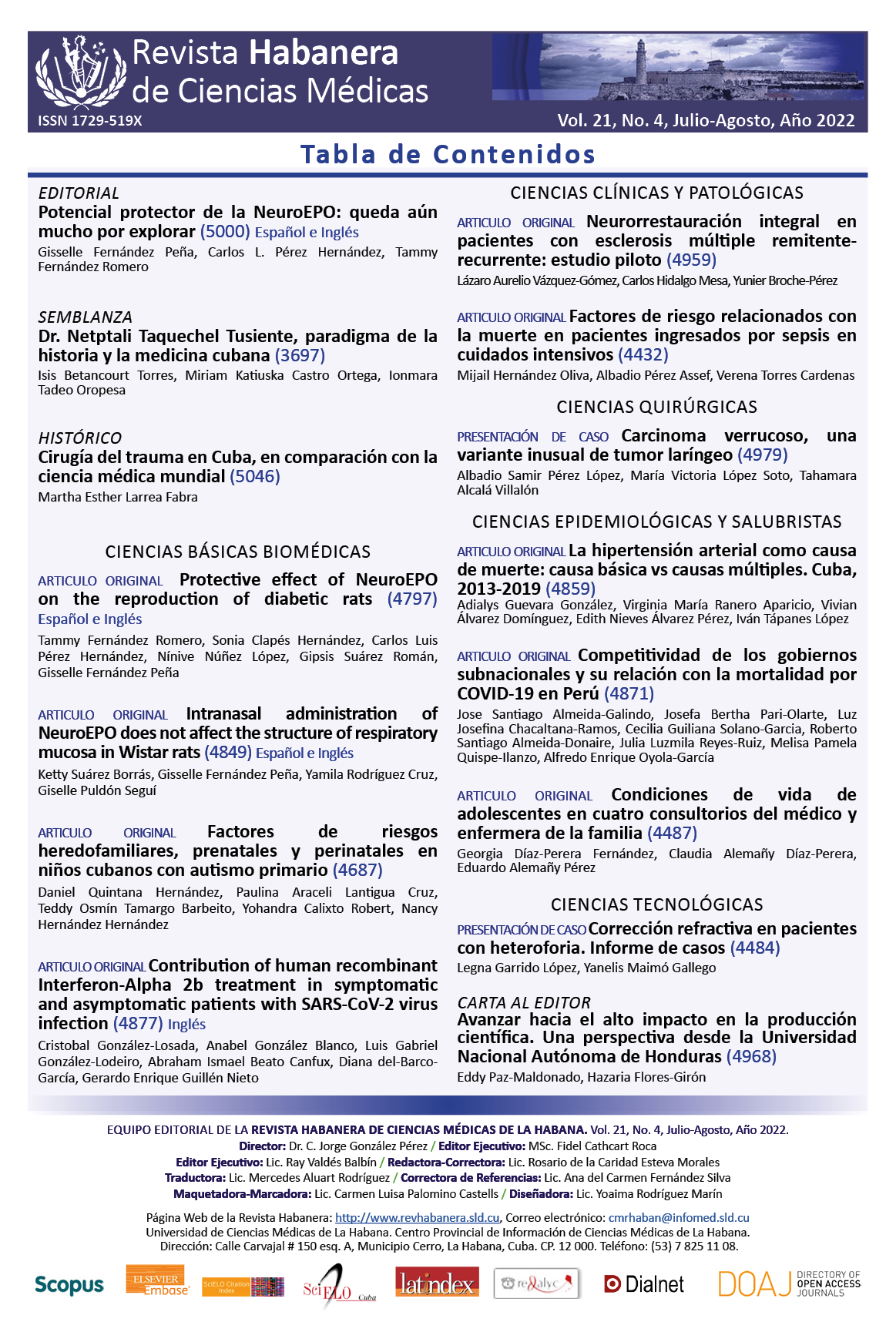Refractive correction in patients with heterophoria. Case reports
Keywords:
refractive formula, fusion, near point of convergence, accommodation-convergence relationship, fusional vergences.Abstract
Introduction: Heterophoria is the misalignment of the ocular axes, which is compensated during binocular fixation using the fusion mechanism. It has a high prevalence in the population.
Objective: To demonstrate the importance of a personalized optical correction in patients with heterophorias.
Cases report: Four cases who attended an ophthalmology consultation for refraction due to asthenopic symptoms are presented. After a complete evaluation of every one of the cases, the presence of heterophoria was found in all of them. The existence of exophoria, mainly associated with insufficient convergence, was determined in three of them; and convergence excess esophoria was identified in one case. Personalized optical correction was indicated in all cases, taking into account the results of the examinations; also, the discomfort in the patients was eliminated.
Conclusions: Heterophorias are a frequent cause of asthenopic symptoms. It is necessary to carry out an adequate study before indicating a refractive correction, considering the identification and quantification of phoria, evaluation of fusional vergences, the study of the near point of convergence, and the accommodation-convergence relationship.
Downloads
References
1. Perea García J. Estrabismos. En su: Tratado de motilidad ocular. 2 ed [Internet]. Madrid: Artes Gráficas Toledo; 2018 [Citado 10/09/2021]. Disponible en: http://www.doctorjoseperea.com/libros.html
2. Babinsky E, Sreenivasan V, Candy TR. Near heterophoria in early childhood. Invest. Ophthalmol & Vis Sci [Internet]. 2015;56(2):1406-15. Disponible en: https://www.doi.org/10.1167/iovs.14-14649
3. León Álvarez A, Medrano SM, Márquez MM. Rangos de referencia de heteroforias y reservas fusionales entre los 6 y los 60 años de edad. Cienc Tecnol Salud Vis Ocul [Internet]. 2017;15(1):47-58. Disponible en: http://dx.doi.org/10.19052/sv.4038
4. Estévez Y, Farías D, Naranjo RM. Forias y microtropías. En: Santiesteban R, editor. Oftalmología Pediátrica. 2 ed. La Habana: Ecimed; 2018. p.126- 133.
5. Bardini R. La Función visual en el análisis optométrico. España: Colegio Nacional de Ópticos Optométricos; 1984.
6. Haradhan Chowdhury P, Haren Shah B. Motor evaluation of strabismus. International Journal of Medical and Health Science [Internet]. 2018 [Citado 06/09/2021];1(1):40-3. Disponible en: https://ephjournal.org/index.php/mhs/article/view/1065
7. Ochoa Peña UH. Procedimientos clínicos para determinar la naturaleza de forias y tropías desde la perspectiva de un optometrista [Tesis Maestría]. Guatemala: Universidad Galileo Facultad de Ciencias de la Salud; 2019 [Citado 10/09/2021]. Disponible en: http://biblioteca.galileo.edu/tesario/bitstream/123456789/1054/1/2019-T-lopt-010_ochoa_pena_ulises_humberto.pdf
8. Dadeya S, Kaur S. Basic Examination of Strabismus. India: Delhi Ophthalmological Society; 2021.
9. Gallego Andrés O. Manual de Exploración Optometría [Tesis de Especialidad en Óptica y Optometría]. España: Universidad de Valladolid; 2015 [Citado 10/09/2021]. Disponible en: http://uvadoc.uva.es/bitstream/10324/25701/1/TFG-G 2405.pdf
10. Bernal Escalante J, Rosenfield M, Casillas Casillas E, Barba Gallardo LF, Ramírez González S, Salas Hernández LH. Validez de las técnicas para evaluar la foria de cerca. Cienc Tecnol Salud Vis Ocul [Internet].
2020;(2):33-8. Disponible en: https://doi.org/10.19052/sv.vol17.iss2.4
11. León Álvarez A, Medrano SM, Márquez MM, Nuñez SM. Disfunciones no estrábicas de la visión binocular entre los 5 y los 19 años. Ciencia y Tecnología para la Salud Visual y Ocular [Internet]. 2016;14(2):13-24. Disponible en: https://doi.org/10.19052/sv.3840
12. Soria Peña L. Protocolo para la evaluación de la función vergencial en un examen optométrico [Tesis de Especialidad]. Sevilla: Universidad de Sevilla; 2017 [Citado 10/09/2021]. Disponible en: https://idus.us.es/xmlui/bitstream/handle/11441/64674/14TFG%20LORENA%20SORIA%20PE%C3%91AS.pdf?sequence=1&isAllowed=y
13. Chavarría Rivera KA, Espinoza Valerio EF, Estrada Blandón JF. Relación entre las disfunciones binoculares no estrábicas y ametropías, en estudiantes de 4to a 5to grado de distintos Colegios del distrito III de la Ciudad de Managua, en el periodo Mayo a Julio 2019 [Tesis de Especialidad]. Managua: Universidad Nacional Autónoma de Nicaragua; 2020 [Citado 10/09/2021]. Disponible en: http://repositorio.unan.edu.ni/id/eprint/15305
14. Chen Z, Li J, Thompson B, Deng D, Yuan J, Chan L, et al. The effect of Bangerter filters on binocular function in observers with amblyopia. Investigative Ophthalmoly & Vision Science [Internet]. 2015;56:139-49. Disponible en: https://www.doi.org/10.1167/iovs.14-15224
15. Hernández Marrero XM, Pereda Marin AY, Ochando Reyes Y, Favars Savigne S, Iglesias Guirado NI, Monteagudo García M. Disfunciones acomodativas y binoculares no estrábicas entre los 16 y 35 años de edad. Revista Cubana de Tecnología de la Salud [Internet]. 2019 [Citado 29/09/2021];10(4):35-45. Disponible en: http://www.revtecnologia.sld.cu/index.php/tec/article/view/1565
16. Durán Silva LM. El examen analítico y su importancia clínica. Método de análisis gráfico. Ciencia y Tecnología para la Salud Visual y Ocular. 2007;8(1):93-104.



